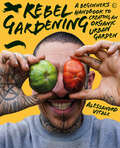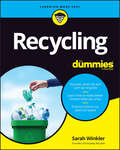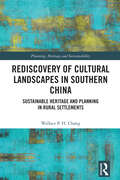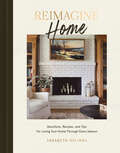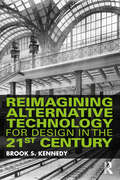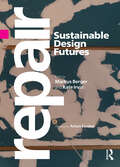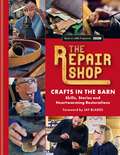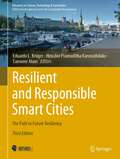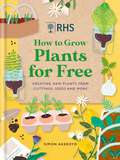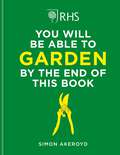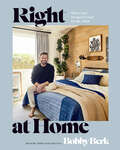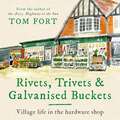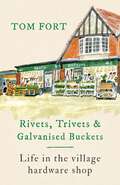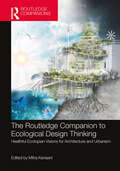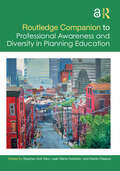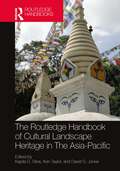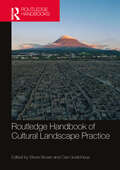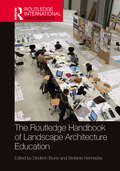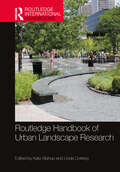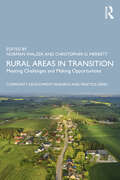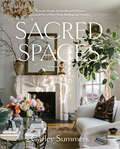- Table View
- List View
Rebel Gardening: A beginner’s handbook to organic urban gardening
by Alessandro VitaleThis is the ultimate beginner&’s guide to establishing and tending an organic kitchen garden in any urban space, no matter how small, written by the YouTuber and TikToker known as Spicy Moustache.Do you live in the city and yearn for the space and time to grow your own food and live more connected with nature and the seasons? Rebel Gardening shows that anyone can grow a garden of delicious organic fruit and vegetables, wildlife-friendly wildflowers and abundant herbs in absolutely any urban space with a bit of know-how.Organic gardening expert Alessandro Vitale wants you to embrace the living soil and establish your own city eden where creatures and plants can coexist, in harmony with our modern lives. He shares his low-cost and organic approach with all the essential guidance you will need, including his top 50 plants for beginner gardeners, with a plethora of information on how to plant and look after them and how to make the most of all your produce. Learn how to make vegan honey with dandelions, establish a micro-orchard, or brew a natural antibiotic from garlic.Alessandro shares a plan for any type of space and how to tend it through the year. Learn about companion gardening, saving seeds, DIY raised beds and everything to allow your garden to flourish. The healing and planet-protecting power of gardening is within your grasp!
Recycling For Dummies
by Sarah WinklerLearn the facts about recycling and discover the best way to make an impact Recycling is a simple action we can take that has an immediate positive effect. It keeps waste out of landfills, conserves natural resources, prevents pollution, and saves energy. Who wouldn’t want to do this? But recycling isn’t always straightforward. With so many different rules, it can be tough to work out the right thing to do. If you’re worried that you’re not recycling properly, or wondering whether you could be recycling more, this is the book for you. Recycling For Dummies cuts through the confusion around what you can and can’t recycle. This easy-to-follow manual breaks down recycling codes, symbols, and rules in a straightforward way that anyone can understand and apply. You’ll gain insight into the recycling process (where does that stuff go, anyway?) and learn tons of tips on reusing items in your daily life to cut down on waste. It also guides you on how to make smarter choices as a consumer to help preserve the planet for generations to come. Figure out what common materials can and can’t be recycled Understand what the recycling symbols are telling you Explore the many specialist recycling services available Learn what happens to your recyclables after they get picked up Become a true recycler by switching to recycled productsCheck out this book if you want to make your efforts count and be part of the recycling solution.
Rediscovery of Cultural Landscapes in Southern China: Sustainable Heritage and Planning in Rural Settlements (Planning, Heritage and Sustainability)
by Wallace P.H. ChangThis book investigates the concept of human landscape in rural settlements in Southern China, where communities and their cultural landscapes are facing contemporary challenges following a period of rapid urbanization in the last 50 years. While metropolitan cities, such as Hong Kong, are experiencing accelerated urban development, underpopulated rural villages are struggling to maintain the cultural heritage of their regions. Rediscovery of Cultural Landscapes in Southern China provides a detailed account into indigenous living cultures in traditional, rural settlements upon natural landscapes. Beginning with an overview of the theoretical framework, the book presents six unique cases, including: Tai O, Yim Tin Tsai, Lai Chi Wo, Nga Tsin Wai, Cangdong, and Meinong, while illustrating a relevant comparison between Hakka and Satoyama landscape systems. The spectrum of theoretical and case analyses allows for a rethinking of the evolving cultural landscape’s positioning with valuable heritages in the context of a post-industrial society. The book is written towards reinterpreting the cultural landscape by conceptualizing the human landscape for scholars, practitioners, and students interested in rural-cultural conservation and revitalization, heritage management, traditional architecture and landscape planning, and urban-rural development.
Reimagine Home: Devotions, Recipes, and Tips for Loving Your Home Through Every Season
by Sarabeth GalimbaSimplify your home and experience the peace God wants for you in every season with twenty-eight encouraging devotions, practical decorating tips, and stunning photography.Home—whether a camper van, mansion, or anything in between—is where we recharge and rest, where we learn and grow, and where we welcome others. And for Christians, our home should be a small reflection of God's kingdom on earth. Unfortunately, our homes often feel anything but peaceful, ordered, or representative of who we are. If this sounds familiar, consider Reimagine Home a gift of inspiration and your personal invitation to quiet all voices of comparison and tune in to what really matters when it comes to your home—creating a space where you can know the love of God and share that love with others. With twenty-eight devotions that span the four seasons of the year, Reimagine Home encourages you to begin creating the home you want on a schedule that works for you, offering customizable tactics, helpful tips, and an undated format. Accompanied by beautifully inspiring, full-color photographs that inspire peace instead of perfection, this devotional provides a sense of calm to each day.As you read each short reflection and explore the practical home styling tips, you will be inspired to curate a home that reflects who you are and welcomes others the moment they walk in the door.
Reimagining Alternative Technology for Design in the 21st Century
by Brook S. KennedyReimagining Alternative Technology for Design in the 21st Century presents a new approach to design that harnesses still-valuable alternative, traditional and abandoned technologies alongside the creation of new ones to address contemporary global problems. It focuses on design opportunities that reduce energy and material consumption to tackle issues such as climate change and pollution in industrialized economies. The book takes the reader on a journey surveying different facets of human activity to identify underused and discarded technologies that could be indispensable today. It critically addresses newer approaches to design and technology by comparing them to existing alternatives, unpacking examples including air conditioning with smart thermostats, electric lighting, durable reusable products, domestic maintenance tools and methods of transportation. Written for practicing designers and students in industrial design, architecture, sustainable design and human-centered design, this book provides new ideas and tools for creating more useful, energy-and-resource-efficient product designs and systems.
Repair: Sustainable Design Futures
by Markus Berger Kate IrvinA collection of timely new scholarship, Repair: Sustainable Design Futures investigates repair as a contemporary expression of empowerment, agency, and resistance to our unmaking of the world and the environment. Repair is an act, metaphor, and foundation for opening up a dialogue about design’s role in proposing radically different social, environmental, and economic futures. Thematically expansive and richly illustrated, with over 125 visuals, this volume features an international, interdisciplinary group of contributors from across the design spectrum whose voices and artwork speak to how we might address our broken social and physical worlds. Organized around reparative thinking and practices, the book includes 30 long and short chapters, photo essays, and interviews that focus on multiple responses to fractured systems, relationships, cities, architecture, objects, and more. Repair will encourage students, academics, researchers, and practitioners in art, design and architecture practice and theory, cultural studies, environment and sustainability, to discuss, engage, and rethink the act of repair and its impact on our society and environment.
The Repair Shop: Skills, stories and heartwarming restorations: THE LATEST BOOK
by Elizabeth Wilhide Jayne DowleThe Repair Shop - the Bafta-award-winning series with regular viewing figures of 7 million in the UK alone - has cemented itself as a BBC classic. Enter a workshop filled with expert craftspeople as they bring loved pieces of family history and the memories they hold back to life.Each expert explains their craft, the reason they love it so much and how they go about restoring and reviving your precious objects, from a Ukrainian suitcase to a matchstick clock, using crafts as varied as leatherwork, woodwork, metalwork, art and ceramic restoration.
The Repair Shop: Skills, stories and heartwarming restorations: THE LATEST BOOK
by Elizabeth Wilhide Jayne DowleThe Repair Shop - the Bafta-award-winning series with regular viewing figures of 7 million in the UK alone - has cemented itself as a BBC classic. Enter a workshop filled with expert craftspeople as they bring loved pieces of family history and the memories they hold back to life.Each expert explains their craft, the reason they love it so much and how they go about restoring and reviving your precious objects, from a Ukrainian suitcase to a matchstick clock, using crafts as varied as leatherwork, woodwork, metalwork, art and ceramic restoration.
Resilient and Responsible Smart Cities: The Path to Future Resiliency (Advances in Science, Technology & Innovation)
by Eduardo L. Krüger Hirushie Pramuditha Karunathilake Tanweer AlamThis book is a compilation of diverse, yet homogenic, research papers that discuss current advances in Earth Observation and Geospatial Information Technologies to tackle new horizons concerning the digitization and information management in smart cities’ infrastructures. The book also tackles the challenges faced by urban planners by the new mega-cities and proposes a series of solutions to resolve complex urban issues. It suggests enhancing the integration of disciplines, thus, bringing together architects, urban planners, civil engineers, landscape designers and computer scientists to address the problems that our cities are facing. This book is a culmination of selected research papers from IEREK’s fourth edition of the International Conference on Future Smart Cities (FSC) and the fourth edition of the International Conference on Resilient and Responsible Architecture and Urbanism (RRAU) held online in collaboration with the XMUM, Selangor, Malaysia (2021).
RHS How to Grow Plants for Free: Creating New Plants from Cuttings, Seeds and More
by Simon AkeroydIncrease your stock of plants easily and for free by propagating them yourself. RHS How to Grow Plants for Free demystifies the art of taking cuttings and explains the other ways you can multiply your garden plants. Propagating your own plants is fun, inexpensive, and a sustainable way to garden.An introductory section explains the botanical science behind all types of propagation and defines and simplifies the language. The book is then split into self-contained practical chapters detailing each of the different types of propagation. Each chapter includes a selection of 'plant profiles' for the plants best suited to eachpropagation method: - Dividing Plants covers the easiest methods of splitting one plant into several new ones- Saving Seeds introduces how to collect and process seeds from flowers, vegetables, herbs and trees- Cuttings covers how to successfully grow a new plant from an existing one using several different methods for taking cuttings- The Houseplants chapter shows techniques needed to increase your collection.- The final chapters show how to grow new plants from kitchen scraps, and gives ideas on how to make the most of all the new plants you've created by giving them as gifts
RHS How to Grow Plants for Free: Creating New Plants from Cuttings, Seeds and More
by Simon AkeroydIncrease your stock of plants easily and for free by propagating them yourself. RHS How to Grow Plants for Free demystifies the art of taking cuttings and explains the other ways you can multiply your garden plants. Propagating your own plants is fun, inexpensive, and a sustainable way to garden.An introductory section explains the botanical science behind all types of propagation and defines and simplifies the language. The book is then split into self-contained practical chapters detailing each of the different types of propagation. Each chapter includes a selection of 'plant profiles' for the plants best suited to eachpropagation method: - Dividing Plants covers the easiest methods of splitting one plant into several new ones- Saving Seeds introduces how to collect and process seeds from flowers, vegetables, herbs and trees- Cuttings covers how to successfully grow a new plant from an existing one using several different methods for taking cuttings- The Houseplants chapter shows techniques needed to increase your collection.- The final chapters show how to grow new plants from kitchen scraps, and gives ideas on how to make the most of all the new plants you've created by giving them as gifts
RHS You Will Be Able to Garden By the End of This Book
by Simon AkeroydThe title might sound like a bold statement, but you really will be able to garden by the end of this book. Whether you are a budding botanist or just aspire to have greener fingers, this book will hold your 'horticultural hand' and guide you gently through the principles of gardening. Whether you have a tiny courtyard or something a bit bigger, this book will share everything you need to know to create your own patch of horticultural heaven. With 12 easy-to-follow chapters that explore all the basics of successful, stress-free gardening including assessing and designing your garden, how to grow fruit and vegetables, plant maintenance, propagation, lawns and container garden. The 15 step-by-step techniques will teach you how to sow seeds, prune shrubs, cut a hedge, mow a lawn and even how to design your own outside space, plus so much more. Just as important, the book explains how to garden sustainably and encourage wildlife, so that you can make informed decisions when it comes to creating and maintaining your garden.
RHS You Will Be Able to Garden By the End of This Book
by Simon AkeroydThe title might sound like a bold statement, but you really will be able to garden by the end of this book. Whether you are a budding botanist or just aspire to have greener fingers, this book will hold your 'horticultural hand' and guide you gently through the principles of gardening. Whether you have a tiny courtyard or something a bit bigger, this book will share everything you need to know to create your own patch of horticultural heaven. With 12 easy-to-follow chapters that explore all the basics of successful, stress-free gardening including assessing and designing your garden, how to grow fruit and vegetables, plant maintenance, propagation, lawns and container garden. The 15 step-by-step techniques will teach you how to sow seeds, prune shrubs, cut a hedge, mow a lawn and even how to design your own outside space, plus so much more. Just as important, the book explains how to garden sustainably and encourage wildlife, so that you can make informed decisions when it comes to creating and maintaining your garden.
Right at Home: How Good Design Is Good for the Mind: An Interior Design Book
by Bobby BerkThe design expert and Emmy-nominated TV host of Netflix&’s Queer Eye shows you how to set up your space so that it takes care of you. Learn how to follow your happiness to find your style, optimize the function of every room, organize your space, and so much more.The way your home makes you feel matters. After all, it&’s your ultimate safe space and needs to be able to host your most intimate conversations and memorable celebrations. So setting it up for comfort, style, and authenticity is essential to your self-care. In Right at Home, Bobby shows you how designing your space, no matter what size home you have, has an impact that&’s immediate, visceral, and undeniable. Learn how to:• Articulate what makes you happy so you can land on a design that reflects your truest style• Prioritize function and comfort so your space works for you (and not the other way around)• Know what to let go of and what to repurpose so that every room stays organized• Engage all your senses with texture, contrast, scent, and sound so you can stay in the present• Understand the emotional impact of color and confidently pick patterns, palettes, and color pops• Maximize lighting (both natural and artificial) to support a positive mental state• Boost your mood by bringing plants and nature into your design Right at Home demonstrates that good design can aid mental wellness and helps us achieve a new sense of happiness within the home. With gorgeous photographs of beautifully styled rooms and Bobby&’s tried-and-true tips, this is the definitive guide to designing a modern home.
Rivets, Trivets and Galvanised Buckets: Life in the village hardware shop
by Tom FortRivets, Trivets and Galvanised Buckets is The Repair Shop meets The Diary of a Bookseller all conveyed in Tom Fort's signature easy-going writing style.Tom Fort made his name as a writer with his bestselling travel narrative The A303: Highway to the Sun. He now focuses on matters closer to home by celebrating a quintessential cornerstone of any village in Britain - the shop - in this case a century-old hardware shop daughter-in-law bought eighteen months before the pandemic struck the UK to run herself in their beautiful Berkshire village, outside of Reading. The family's dream of developing the shop into one that would become the centre of village life certainly did come true, but for a very different set of circumstances. Rivets, Trivets and Galvanised Buckets interweaves the evolution of the shop, its previous owners, and the history of the items it sells, to its customers to present a delightful study of community and the eccentricities of ordinary people.The nationwide lockdown focused minds on the home and its immediate surroundings, i.e. the garden. People were forced to look differently at where they lived, and found ways to value that, and enhance it. They learned or relearned the pleasure and fulfilment of deploying practical skills. And they came to Tom's family shop to buy and to talk about what all this meant to them. Married to this personal story will be Tom's history of home ownership and how it nourished pride in the home and the desire to make the home better and more beautiful, and how technological progress in the mass production of tools and materials made it easy to realise - or attempt to realise - those ambitions.Rivets, Trivets and Galvanised Buckets offers fascinating history of technological progress: who thought of screwdrivers, where the Stanley knife came from, who devised the process of galvanisation, what genius worked out that a suction pad on the end of a piece of wood could unblock sinks and so forth. As Tom recounts: 'A little girl came with her father into Heath and Watkins, looked around for a while and said to him "Daddy, this is the shop of EVERYTHING". This is the story of how this happened.(P) 2023 Headline Publishing Group Ltd
Rivets, Trivets and Galvanised Buckets: Life in the village hardware shop
by Tom FortTom Fort made his name as a writer with his bestselling travel narrative The A303: Highway to the Sun. He now focuses on matters closer to home by celebrating a quintessential cornerstone of any village in Britain - the shop - in this case a century-old hardware shop daughter-in-law bought eighteen months before the pandemic struck the UK to run herself in their beautiful Berkshire village, outside of Reading. The family's dream of developing the shop into one that would become the centre of village life certainly did come true, but for a very different set of circumstances. Rivets, Trivets and Galvanised Buckets interweaves the evolution of the shop, its previous owners, and the history of the items it sells, to its customers to present a delightful study of community and the eccentricities of ordinary people.The nationwide lockdown focused minds on the home and its immediate surroundings, i.e. the garden. People were forced to look differently at where they lived, and found ways to value that, and enhance it. They learned or relearned the pleasure and fulfilment of deploying practical skills. And they came to Tom's family shop to buy and to talk about what all this meant to them. Married to this personal story will be Tom's history of home ownership and how it nourished pride in the home and the desire to make the home better and more beautiful, and how technological progress in the mass production of tools and materials made it easy to realise - or attempt to realise - those ambitions.Rivets, Trivets and Galvanised Buckets offers fascinating history of technological progress: who thought of screwdrivers, where the spirit level came from, who devised the process of galvanisation, what genius worked out that a suction pad on the end of a piece of wood could unblock sinks and so forth. As Tom recounts: 'A little girl came with her father into Heath and Watkins, looked around for a while and said to him "Daddy, this is the shop of EVERYTHING". This is the story of how this happened.
The Routledge Companion to Ecological Design Thinking: Healthful Ecotopian Visions for Architecture and Urbanism
by Mitra KanaaniThis companion investigates the ways in which designers, architects, and planners address ecology through the built environment by integrating ecological ideas and ecological thinking into discussions of urbanism, society, culture, and design. Exploring the innovation of materials, habitats, landscapes, and infrastructures, it furthers novel ecotopian ideas and ways of living, including human-made settings on water, in outer space, and in extreme environments and climatic conditions. Chapters of this extensive collection on ecotopian design are grouped under five different ecological perspectives: design manifestos and ecological theories, anthropocentric transformative design concepts, design connectivity, climatic design, and social design. Contributors provide plausible, sustainable design ideas that promote resiliency, health, and well-being for all living things, while taking our changing lifestyles into consideration. This volume encourages creative thinking in the face of ongoing environmental damage, with a view to making design decisions in the interest of the planet and its inhabitants. With contributions from over 79 expert practitioners, educators, scientists, researchers, and theoreticians, as well as planners, architects, and engineers from the U.S., Canada, Europe, and Asia, this book engages theory, history, technology, engineering, and science, as well as the human aspects of ecotopian design thinking and its implications for the outlook of the planet.
Routledge Companion to Professional Awareness and Diversity in Planning Education
by Stephen Kofi Diko Leah Marie Hollstein Danilo PalazzoThe Routledge Companion to Professional Awareness and Diversity in Planning Education engenders a discourse on how urban planning as a discipline is being made attractive to children and youth as they consider their career preferences. It also provides a discourse around the diversity challenges facing the institutions for training urban planning professionals. This Companion is an impressive collection of initiatives, experiences, and lessons in helping children, youth, and the general public appreciate the importance of, and the diversity challenge confronting, the urban planning profession and education. It comprises empirical, experimental, and case study research on initiatives to address the professional awareness and diversity challenges in urban planning. It has uniquely assembled voices and experiences from countries in Africa, Asia, Europe, and North America. Contributors are educators, practitioners, and activists of urban planning as well as policymakers in their respective countries. This Companion is intended as a resource for urban planning schools and departments, foundations, non-profit organizations, private sector organizations, public institutions, teachers, and alumni, among others to learn and consciously drive efforts to increase planning education awareness among children, youth, and the general public.
Routledge Companion to Professional Awareness and Diversity in Planning Education
by Stephen Kofi Diko Leah Marie Hollstein Danilo PalazzoThe Routledge Companion to Professional Awareness and Diversity in Planning Education engenders a discourse on how urban planning as a discipline is being made attractive to children and youth as they consider their career preferences. It also provides a discourse around the diversity challenges facing the institutions for training urban planning professionals.This Companion is an impressive collection of initiatives, experiences, and lessons in helping children, youth, and the general public appreciate the importance of, and the diversity challenge confronting, the urban planning profession and education. It comprises empirical, experimental, and case study research on initiatives to address the professional awareness and diversity challenges in urban planning. It has uniquely assembled voices and experiences from countries in Africa, Asia, Europe, and North America. Contributors are educators, practitioners, and activists of urban planning as well as policymakers in their respective countries.This Companion is intended as a resource for urban planning schools and departments, foundations, non-profit organizations, private sector organizations, public institutions, teachers, and alumni, among others to learn and consciously drive efforts to increase planning education awareness among children, youth, and the general public.Chapter 6 of this book is freely available as a downloadable Open Access PDF at http://www.taylorfrancis.com under a Creative Commons Attribution-Non Commercial-No Derivatives (CC-BY-NC-ND) 4.0 license.
The Routledge Handbook of Cultural Landscape Heritage in The Asia-Pacific (Routledge Handbooks on Museums, Galleries and Heritage)
by Ken Taylor David S. Jones Kapila D. SilvaThe Routledge Handbook of Cultural Landscape Heritage in the Asia-Pacific revisits the use, growth, and potential of the cultural landscape methodology in the conservation and management of culture-nature heritage in the Asia-Pacific region. Taking both a retrospective and prospective view of the management of cultural heritage in the region, this volume argues that the plurality and complexity of heritage in the region cannot be comprehensively understood and effectively managed without a broader conceptual framework like the cultural landscape approach. The book also demonstrates that such an approach facilitates the development of a flexible strategy for heritage conservation. Acknowledging the effects of rapid socio-economic development, globalization, and climate change, contributors examine the pressure these issues place on the sustenance of cultural heritage. Including chapters from more than 20 countries across the Asia-Pacific region, the volume reviews the effectiveness of theoretical and practical potentials afforded by the cultural landscape approach and examines how they have been utilized in the Asia-Pacific context for the last three decades. The Routledge Handbook of Cultural Landscape Heritage in the Asia-Pacific provides a comprehensive analysis of the processes of cultural landscape heritage conservation and management. As a result, it will be of interest to academics, students, and professionals who are based in the fields of cultural heritage management, architecture, urban planning, landscape architecture, and landscape management.
Routledge Handbook of Cultural Landscape Practice (Routledge International Handbooks)
by Steve Brown Cari GoetcheusCultural landscapes, which in the field of heritage studies and practice relates to caring for and safeguarding heritage landscapes, is a concept embedded in contemporary conservation. Heritage conservation has shifted from an historical focus on buildings, city centres, and archaeological sites to encompass progressively more diverse forms of heritage and increasingly larger geographic areas, embracing both rural and urban landscapes. While the origin of the idea of cultural landscapes can be traced to the late-19th century Euro-American scholarship, it came to global attention after 1992 following its adoption as a category of ‘site’ by the UNESCO World Heritage Committee. Today, cultural landscape practice has become increasingly complex given the expansion of the values and meanings of heritage, the influence of environmental challenges such as human induced climate change, technological advancements, and the need to better understand and interpret human connections to place and landscapes. The aim of this handbook is to strike a balance between theory and practice, which we see as inseparable, while also seeking to achieve a geographical spread, disciplinary diversity and perspectives, and a mix of authors from academic, practitioner, management, and community backgrounds.
The Routledge Handbook of Landscape Architecture Education (Routledge International Handbooks)
by Diedrich Bruns Stefanie HenneckeIn this handbook, 60 authors, senior and junior educators, and researchers from six continents provide an overview of 200 years of landscape architectural education. They tell the stories of schools and people, of visions, and of experiments that constitute landscape architecture education heritage. Through taking an international perspective, the handbook centers inclusivity with an appreciation for how education develops in different political and societal contexts. Part I introduces the field of education history research, including research approaches and international research exchange. Spanning more than 100 years, Parts II and III investigate and compare early and recent histories of landscape architecture education in different countries and schools. In Part IV, the book offers new perspectives for landscape architecture education. Education research presents a substantial opportunity for challenging studies to increase the pedagogic and didactic, the academic and historic, and the disciplinary knowledge basis. Through a boundary-crossing approach, these studies about landscape architecture education provide a reference to teachers and students, policymakers, and administrators, who strive for innovative, holistic, and interdisciplinary practice.
Routledge Handbook of Urban Landscape Research (Routledge International Handbooks)
by Kate Bishop Linda CorkeryLandscape architecture is one of the key professions dedicated to making cities hospitable and healthy places to live, work and play, while respecting and enhancing the natural environments and landscapes we inhabit. This edited collection presents current writing about the pivotal roles that landscape architects play in addressing some of the most pressing problems facing the planet, its environments and its populations through their research, analysis and speculative practice. The book has assembled current writings on recent research structured around five major themes: governance, power and partnership; infrastructure, systems and performance; environment, resilience and climate change; people, place and design; and culture, heritage and identity. As a collection, the chapters demonstrate the diversity of themes and topics that are expanding the scholarly body of knowledge for the discipline and its relevance to the practice of landscape architecture. The contributors to this book are academic researchers and practitioners from the discipline of landscape architecture. The chapters draw on their research, teaching and experience as well as analysis of project examples. Fifty-two contributors from the United Stsates, United Kingdom, Sweden, Denmark, the Netherlands, Nigeria, Malaysia, Spain, Colombia, Australia, New Zealand and Canada discuss a diverse range of contemporary themes in urban landscape architecture. Collectively, the contributors demonstrate the breadth of experience, shared concerns and distinct issues that challenge urban landscape architecture and cities in the 21st century.
Rural Areas in Transition: Meeting Challenges & Making Opportunities (Community Development Research and Practice Series)
by Norman Walzer Christopher D. MerrettThis volume explores new opportunities to reshape local economies in rural areas during the next decade by exploring successful efforts already underway. While reported population declines can paint a bleak picture for rural areas, a different story can be told in looking at the numbers of households, employment, and housing markets. In fact, many rural areas have had steady employment and healthy housing markets. Rural attractions often include proximity to natural recreation areas, personal safety, social interaction, less expensive housing, and high-quality education. This book shows that rural areas are in a major long-term transition and that local leaders who take advantage of these opportunities in their community and economic development strategies can create a very positive future for residents. Students and policymakers in local economic development, sociology of population change, business finance, political economy, and geography will find this a useful resource.
Sacred Spaces: Everyday People and the Beautiful Homes Created Out of Their Trials, Healing, and Victories
by Carley SummersA gorgeous photography collection, featuring home interiors and profiles of the people who have transformed these spaces into sanctuaries, calling you to create your own sacred space &“This book is brimming with heart and healing, and it is a moody, visual feast that will leave you feeling full in the best way possible.&”—Justina Blakeney, designer, author, and founder of JungalowBefore she became an internationally renowned designer and photographer, Carley Summers suffered from alcoholism and addiction, spending nights in jail, the emergency room, and rehab. As someone who celebrates recovery today, she knows firsthand the importance of a warm and inviting home. Summers uses her life experience and her craft to ensure that the homes she photographs and designs are comforting, healing spaces to live and grow in.Sacred Spaces takes readers on a beautifully photographed journey inside fourteen homes, from North Carolina and California to Canada, France, and Morocco, as Summers uncovers the vulnerable stories behind each one: a mother who uses her kitchen to heal her son with food, a woman who found her sanctuary after overcoming childhood abuse, and more. She even offers a tour of her mother&’s home and her own. Along the way, each section identifies a type of space that people have created, including• The Foundational Home, which features those who have created spaces on a solid foundation for a lasting legacy• The Wandering Home, which highlights people who were lost in life, lost in travels, but never lost in their home• The Cathartic Home, which showcases people who realize that when they cannot change the outside world, they can change the inside of their homes to bring comfort through renewal and restorationThis collection is a balm for those seeking refuge in a world fraught with struggle and heartache. Through stories of brokenness, hurt, and healing, Sacred Spaces invites readers to dream of the home that will set them free.
